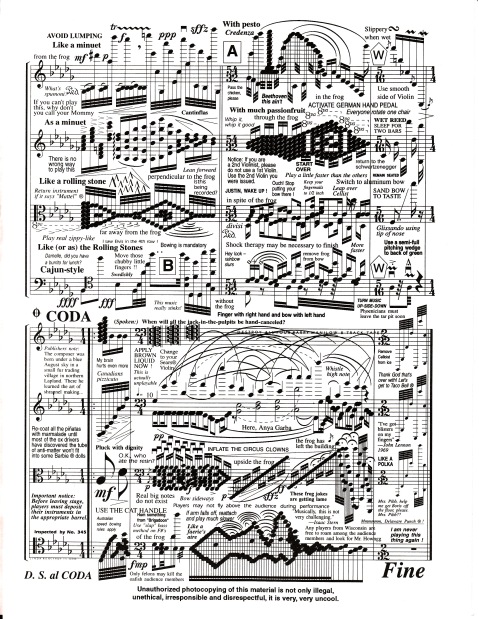Beyond the flashcards, I've tried the idea that involves writing the finger numbers alone on a sheet of paper in order to introduce reading, but I also don't like the student to get too used to using only numbers. I've found they get stuck on this, and it makes the transition to note reading more difficult in some cases. As a transitional option in lieu of this, I like to introduce notes without the lines of the staff. This seems to be a less overwhelming option than using a full staff, and allows the student to get used to seeing notes and to become familiar with note values, without the visual confusion of the lines. I like that it can still show the relative positioning of the notes, as they would appear on the staff normally - higher or lower relative to one another - but removes an element that can be potentially overwhelming for very young students (lines, lines, and more lines!).
 |
| String Quartet no. 556b for Strings in A minor (Motoring Accident) Decomposed by John Stump |
Now check out this option instead:
 |
| Introducing Note Reading to Pre-Reading Students (No Staff Lines) |
As an example, I've posted some beginning violin sheet music for you to download for free! I've made an arrangement of Mary Had a Little Lamb violin duet, with a simple 1st violin part and a very simple 2nd violin part (open strings only). I have two versions, one without staff lines and one with staff lines. I hope you can read it okay. Somehow it lost quality when converting to PDF.
Mary Had a Little Lamb With Staff Lines
Mary Had a Little Lamb Without Staff Lines
Let me know how it goes with your students. Also, feel free to comment and let me know if there are other pieces you'd like me to arrange this way.
UPDATE:
I now also have arrangements of Hot Cross Buns available for free download!
Hot Cross Buns With Staff Lines
Hot Cross Buns Without Staff Lines



Excited to use this with my 5 year-old student! Thanks for sharing!
ReplyDeleteThanks for commenting, Ruth. I'd love to hear how it goes. You can also do your own arrangements as well and remove the staff lines. I used an older version of Finale, but it can probably be done in newer versions as well, and then searched through the Help section to find out how to remove the lines and make the notes bigger.
Delete